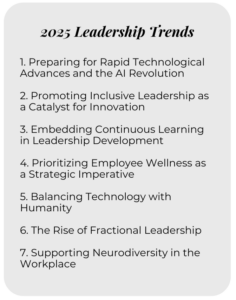Navigating the Future with Agility, Inclusivity, and Purpose
As we approach 2025, the leadership landscape continues to evolve at a rapid pace. The challenges and opportunities that lie ahead demand more than just a reactive approach—these trends require leaders to step forward with a proactive mindset, equipped with the tools and insights needed to navigate this transformative era. From groundbreaking technological advancements to the shifting dynamics of the workplace, the coming year will test leaders’ adaptability, emotional intelligence, and strategic vision.

Success in 2025 will belong to those who can balance innovation with humanity, drive results while fostering inclusivity, and embrace continuous learning as a non-negotiable principle. Leadership trends are no longer confined to traditional roles; they are dynamic forces that shape how organizations thrive and how individuals contribute to a shared vision. Below, we examine the key leadership trends that will define the year ahead and provide actionable insights to help leaders rise to the occasion.
1. Preparing for Rapid Technological Advances and the AI Revolution
The era of artificial intelligence (AI) is here, and its impact is undeniable. For leaders, the ability to integrate AI into strategic decision-making processes is no longer optional—it is a fundamental requirement for success.
To lead effectively in 2025, leaders must adopt a mindset of continuous learning, agility, and innovation. Staying ahead of technological advancements will demand a deliberate effort to understand and implement AI-driven solutions that enhance efficiency, productivity, and competitive advantage.
Leaders who embrace AI as an ally rather than a threat will not only future-proof their organizations but also position themselves as pioneers in a rapidly evolving landscape. This trend is reshaping industries and pushing leadership into new realms of possibility.
Grab the Using ChatGPT to Enhance Leadership Effectiveness download
2. Promoting Inclusive Leadership as a Catalyst for Innovation
Despite the move away from Diversity, Equity, and Inclusion initiatives by many companies, the ability to harness the power of diversity will still be a defining characteristic of successful leadership. In 2025, inclusive leadership will serve as a cornerstone for driving innovation and collaboration.
Effective leaders act as “Connectors-in-Chief,” fostering environments where diverse perspectives are not just welcomed but actively encouraged. This approach requires cultural competence, empathy, and the ability to build cohesive teams that reflect the broader society.
Organizations that prioritize inclusivity in their leadership development strategies will unlock greater innovation, higher employee engagement, and stronger business outcomes. This trend positions inclusive leadership as a key driver for organizational success in the coming year.
3. Embedding Continuous Learning in Leadership Development
In an era of constant change, continuous learning is not merely a best practice—it is a survival strategy. The Global Workforce 2024 Survey highlights that job seekers prioritize learning opportunities as a critical factor in their decision-making.
For organizations, this underscores the importance of embedding a culture of learning within leadership development programs. Leaders must model a growth mindset, encouraging their teams to embrace challenges and seek knowledge.
Providing access to robust learning resources, incentivizing skill development, and recognizing achievements will ensure that leaders and employees alike remain agile and effective. This trend reinforces the importance of lifelong learning in achieving sustained leadership excellence.
4. Prioritizing Employee Wellness as a Strategic Imperative
The link between employee wellness and organizational success is irrefutable, as proven by this remaining a top focus from 2024. In 2025, leaders must go beyond talking about it to implement comprehensive wellness initiatives that address physical, mental, and emotional health.
Healthy employees are more engaged, productive, and creative. Leaders who champion wellness programs demonstrate a commitment to their teams’ well-being, fostering loyalty and reducing turnover.
From mental health support to flexible work arrangements, leaders must prioritize holistic approaches to wellness that align with the demands of a modern workforce. This trend highlights wellness as not just a benefit, but a critical strategy for organizational sustainability.
5. Balancing Technology with Humanity
As AI continues to permeate the workplace, there will be a noticeable shift toward preserving the human element in leadership. Technology can streamline processes, but it cannot replicate emotional intelligence, empathy, or ethical decision-making.
Leaders must recognize the limitations of AI and emphasize the importance of human oversight. By leveraging technology while maintaining a focus on people, leaders will strike a balance that ensures both efficiency and authenticity.
This trend underscores the enduring value of trust, connection, and purpose in leadership, ensuring that organizations do not lose sight of what makes them uniquely human.
6. The Rise of Fractional Leadership
The traditional employment model for C-suite executives is undergoing a transformation. In 2025, the demand for fractional leadership—where leaders provide expertise on a part-time or freelance basis—will reach new heights.
This trend reflects a broader desire for autonomy, flexibility, and meaningful work. Organizations that adapt to this model will gain access to top-tier talent while benefiting from diverse perspectives.
For leaders, fractional roles offer the freedom to pursue varied opportunities, making this a win-win for both professionals and organizations. This trend will redefine how executive leadership is structured and accessed.
7. Supporting Neurodiversity in the Workplace
Efforts are expanding to better accommodate neurodivergent employees, recognizing the unique strengths they bring to the table.
Neurodivergent individuals often excel in areas such as creativity, problem-solving, and pattern recognition. Leaders must create environments that support these employees, providing flexibility, resources, and understanding to ensure their success.
By fostering an inclusive culture, organizations can unlock untapped potential and drive innovation, while neurodivergent employees experience higher levels of satisfaction and engagement. This trend reaffirms the value of diversity in all its forms.
Key Takeaways for Leaders in 2025
The leadership trends of 2025 are a call to action. Leaders must embrace technological advancements without losing sight of their humanity. They must champion inclusivity, prioritize wellness, and foster a culture of continuous learning to navigate the complexities of the modern workplace.
Those who rise to the occasion will not only drive organizational success but also set the standard for impactful, purpose-driven leadership. The future demands leaders who are prepared, informed, and unwavering in their commitment to excellence.
As we step into 2025, the message is clear: Leadership is not static—it is a dynamic force that shapes the trajectory of individuals, teams, and organizations. By aligning with these trends, leaders can position themselves and their organizations for long-term success. The time to act is now.
References:
https://www.kornferry.com/insights/featured-topics/leadership/top-5-leadership-trends-2025
https://www.forbes.com/sites/sallypercy/2024/12/19/5-leadership-trends-that-will-help-to-shape-2025/

Recent Comments